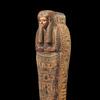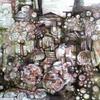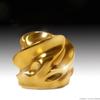The Mona Lisa of the Isle de Noé Castle Hits the Market
- PARIS, France
- /
- November 08, 2021
Christie's is set to present an undisclosed 19th century replica of the Mona Lisa. This beautiful interpretation is named after the Isle de Noé castle where it has been kept in the Gers region by Toulouse since its acquisition in 1845-1846 by William de Noé (estimate : €60,000-100,000). Unknown to the market since then, this Mona Lisa will be offered for the very first time on November 23 in Paris. This first public appearance could therefore be as sensational as its incredible rediscovering in the attic of a Nancy property in the 19th century.
Pierre Etienne, International Director of the Old Master paintings and 19th century department: “Art challenges, fascinates, sometimes obsesses. We are exciting to offer this Mona Lisa named after the Isle de Noé castle, where she has been kept since the first half of the 19th century. Last June, Christie’s France achieved a new record for a replica of the world’s most famous painting, the Hekking’s Mona Lisa, which was sold online for €2,9 million. This later version of very high quality, should once again illustrate the fascination of the Mona Lisa through the centuries and Leonardo da Vinci’s aura in art history.”
It is certainly one of the most recognizable images in the world. The original version of the Mona Lisa entered the royal collections of François Ier in France, shortly after 1517. Several copies were made from the 17th century onwards, including this example, which is an early 19th century remake of Leonardo’s Mona Lisa. Copying the Mona Lisa, a symbol of the Renaissance in all its splendor, can be considered a kind of mandatory rite of passage for artists throughout the ages. The image remains as striking and as fascinating as ever.
The resurgence of the Mona Lisa of the Isle de Noé Castle is compelling in many different senses. The way she reappeared in the mid-19th century is indeed almost miraculous. Forgotten and covered with dust, the canvas was used to block the window of the Nancy property’s attic where it was kept. William de Noé, squadron leader of the first hussar, acquired it there, in 1845-1846, and repatriated it to the family castle of Isle de Noé located in the Gers region. The 23 November sale is an event in itself since this Mona Lisa has remained completely unknown to the market until now and has never appeared in a public sale catalogue. In fact, the work had never left the Isle de Noé castle until the family sold it to an art collector in 1983.
The Isle de Noé castle was completed under the direction of the architect Pierre Racine at the behest of the Marquess Jacques Roger de Noé. His son, Louis Pantaléon de Noé, was the owner of a vast plantation in Saint-Domingue. He is particularly famous for freeing Toussaint Louverture in 1776, long before France abolished slavery. Back in the Isle de Noé castle, the family notoriously maintained close and good relations with the legendary general, leader of the Haitian Revolution.


_Infinity_by_Santiago_Medina_PhotoCr100x100_c.jpg)













